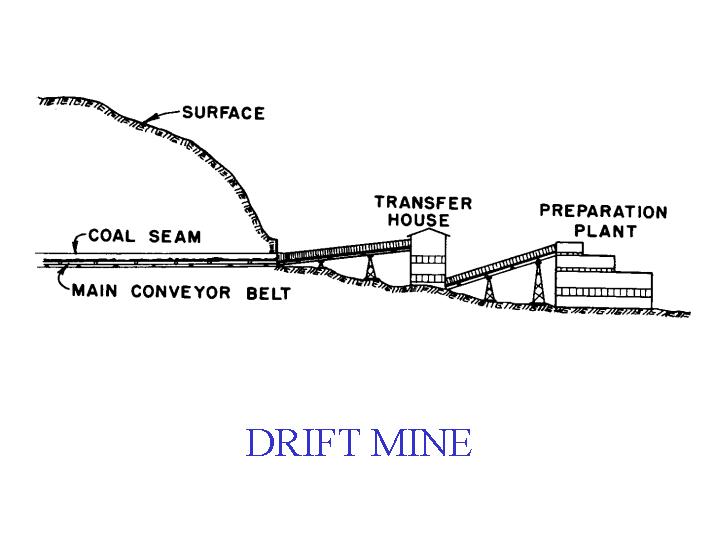- Drift mining
- Shaft mining
- Room and pillar mining
- Continuous mining
- Longwall mining
Drift Mining
Drift mining is only possible when the coal seam is horizontal with the surface, thus allowing not much digging because it's on the side surface of mountains and hills.
Advantages:

Advantages:
- Easier to obtain coal because it falls down the slope.
- When drift mining first started, it was very dangerous because shafts would cave in, causing lots of deaths for miners.

Shaft Mining
Shaft mining the most common type of mining in West Virginia. Elevators are set on the land's surface and then allows the elevators to go underground. Miners then dig to get to the coal in the shaft and take back coal to the elevators up to land to be processed. Miners are at least 1000 feet below the Earth's surface, and is quite dangerous.
Advantages:
- Shaft mining is the deepest form of mining, allowing miners to get coal that is deeper in the Earth's core.
- The large movement of air helps circulate for miners, but also gets rid of toxic gas buildup.
- Shaft mines are useless after all the coal is taken away from the shafts. It is easier to shut down the mine, rather than trying to reuse it. It can be very dangerous.
- Over time, beams that support the shaft can rot away, causing roof breaks.

Room and Pillar Mining
This is one of the least effective types of mining coal, considering at least half of the coal mined has to be kept in the ground to support the mine roof. Pillars supporting the roof can squeeze from pressure, causing a collapse, making Room and Pillar mining quite dangerous. Roof falls are always a constant danger.
Advantages:
- No major advantages.
Disadvantages:
- It is very ineffective.
- Doesn't make much of a profit.
- Pillars have to be moved or replaced often, making it unsafe for workers.

Continuous Mining
In this type of mining, a variety of machines are used for mining, rather than a lot of workers. There are still workers, but they operate the machines, which is safer. One miner can operate a rotating steel drum that can process at least five tons of coal per minute.
Advantages:
- The use of machines are enforced.
- The machines do way more work in a small amount of time.
- Malfunctions on machines.
- Machine related accidents for miners.

Longwall Mining
This is also known as "retreat mining." Large mining machines support the underground roof with hydraulics as it removes coal. When the coal is removed, the roof is then allowed to fall. Longwall mining is very similar to Room and Pillar mining, but is safer and much more effective.
Advantages:
- Longwall mining is usually used after old room and pillar mines are no longer usable, allowing it to be reused.
Disadvantages:
- There have been several reports of surfaces dropping, causing lots of water leakage problems.

No comments:
Post a Comment